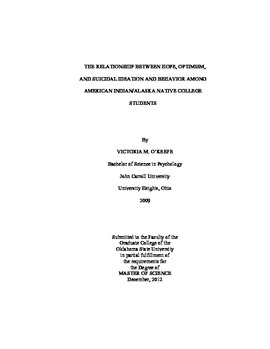| dc.contributor.advisor | Wingate, LaRicka R. | |
| dc.contributor.author | O'Keefe, Victoria | |
| dc.date.accessioned | 2014-04-15T22:23:55Z | |
| dc.date.available | 2014-04-15T22:23:55Z | |
| dc.date.issued | 2012-12-01 | |
| dc.identifier.uri | https://hdl.handle.net/11244/9452 | |
| dc.description.abstract | American Indians/Alaska Natives (AI/AN) exhibit extremely high suicide prevalence rates in comparison to other ethnic groups in the United States. Although epidemiological data continues to provide alarming statistics, there is a dearth of research investigating the underlying factors associated with AI/AN suicidal behavior. Such investigation can aid in investigating why AI/AN populations are overrepresented in suicidal behavior and suicide mortality rates. Furthermore, the extant literature on AI/AN suicide has focused on risk factors, and little attention is paid to protective factors against suicide. A novel approach to the study of protective factors against AI/AN suicide may be in employing positive psychology methods. Research is beginning to shed light on how these positive psychological constructs buffer against psychological disorders. The purpose of the present study was to investigate the relationship between hope and optimism as protective factors against suicidal ideation and suicide attempts amongst AI/AN college students. First, it was hypothesized that hope would be negatively associated with suicidal ideation and suicide attempts, after controlling for symptoms of depression and substance use, among AI/AN college students. Second, it was hypothesized that optimism would be negatively associated with suicidal ideation and suicide attempts, after controlling for symptoms of depression and substance use, among AI/AN college students. Lastly, it was hypothesized that optimism would have a stronger negative relationship than hope with suicidal ideation and suicide attempts, after controlling for symptoms of depression and substance use, for AI/AN college students. Results did not support the hypotheses, as hope and optimism did not negatively predict suicidal ideation and suicide attempts. Hope and optimism should continue to be examined within the context of suicidal ideation and behavior for AI/AN to see if they are protective factors against suicidal ideation and behavior. | |
| dc.format | application/pdf | |
| dc.language | en_US | |
| dc.publisher | Oklahoma State University | |
| dc.rights | Copyright is held by the author who has granted the Oklahoma State University Library the non-exclusive right to share this material in its institutional repository. Contact Digital Library Services at lib-dls@okstate.edu or 405-744-9161 for the permission policy on the use, reproduction or distribution of this material. | |
| dc.title | Relationship Between Hope, Optimism, and Suicidal Ideation and Behavior Among American Indian/Alaska Native College Students | |
| dc.type | text | |
| dc.contributor.committeeMember | Chaney, John | |
| dc.contributor.committeeMember | Grant, DeMond | |
| osu.filename | OKeefe_okstate_0664M_12406.pdf | |
| osu.college | Arts and Sciences | |
| osu.accesstype | Open Access | |
| dc.description.department | Department of Psychology | |
| dc.type.genre | Thesis | |
| dc.subject.keywords | american indian/alaska native | |
| dc.subject.keywords | hope | |
| dc.subject.keywords | optimism | |
| dc.subject.keywords | suicide | |
